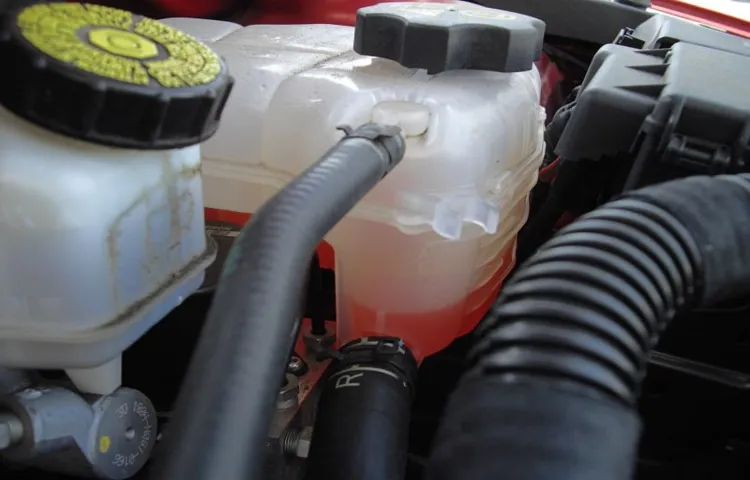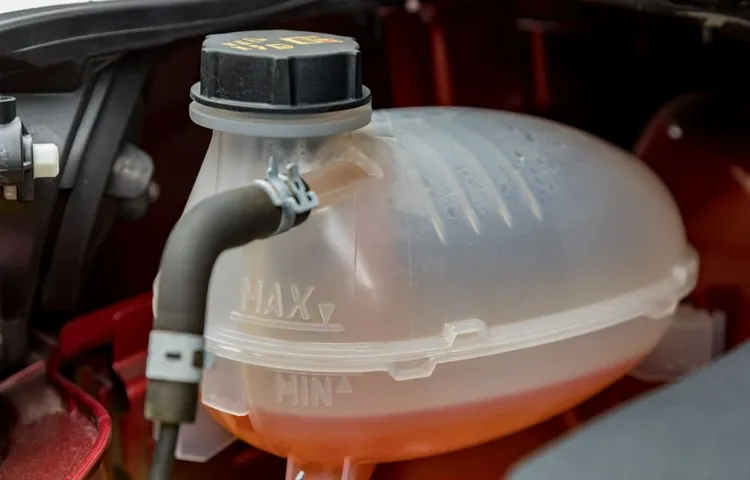Have you ever wondered how full your coolant should be? It’s a question that many car owners may have, but may not know the answer to. The truth is, the coolant level in your car is essential to its proper functioning and can impact the longevity of your vehicle. In this blog post, we’ll dive into the details of how full your coolant should be, and why you should keep an eye on it.
Whether you’re a seasoned car owner or a novice, read on to learn more about this critical aspect of vehicle maintenance.
Table of Contents
Understanding coolant levels
When it comes to checking your vehicle’s coolant level, it’s important to know how full it should be. Generally, the coolant level should be between the “minimum” and “maximum” markings on the coolant reservoir or radiator. However, keep in mind that the level may vary depending on the make and model of your vehicle.
It’s a good idea to refer to your owner’s manual for specific instructions. It’s important to keep your coolant at the proper level because it helps regulate the engine’s temperature and prevents overheating. If you notice that your coolant level is consistently low, it could be a sign of a leak or other issue and should be checked by a professional.
In summary, make sure to check your coolant regularly and keep it at the appropriate level to maintain the health of your vehicle’s engine.
The role of coolant in your vehicle
Coolant is a crucial component in any vehicle, as it helps to regulate the engine’s temperature and prevent overheating. Understanding coolant levels is critical, as it can make the difference between a healthy engine and one that is damaged. Coolant levels should be checked regularly, and topped up if necessary.
A good way to check coolant levels is to look at the coolant reservoir, which is usually located near the radiator. Coolant should be between the minimum and maximum marks on the reservoir, and if it is lower than the minimum mark, it needs to be topped up. Remember, coolant should only be added when the engine is cool, so be sure to check it after the car has been in use for a while.
In addition to checking coolant levels, it is important to ensure that the coolant mixture is correct. This mixture should be approximately 50:50 coolant and water, and it is important to use the right type of coolant for your vehicle. By understanding the role of coolant in your vehicle and paying attention to its levels and mixture, you can help to keep your engine running smoothly and avoid costly repairs down the line.

Factors affecting coolant levels
Coolant levels are an essential component of ensuring your vehicle runs smoothly and efficiently. Several factors can affect coolant levels, including leaks or a malfunctioning coolant reservoir. If coolant levels drop too low, it can cause the engine to overheat, leading to potential engine damage.
It’s crucial to regularly check the coolant levels and inspect for any leaks or malfunctions. Factors such as extreme weather conditions, driving habits, and the coolant’s age can also impact the coolant level. It’s recommended to check your coolant levels every six months or have your vehicle professionally serviced to ensure optimal performance.
Don’t overlook the importance of coolant levels to keep your vehicle running correctly and prevent costly repairs.
Checking your coolant level
If you’re wondering how full your coolant should be, the answer is that it should be at the maximum level indicated on your car’s coolant reservoir. The reservoir can usually be found near the radiator and has a minimum and maximum level marked on it. It’s important to check the coolant level regularly to prevent your engine from overheating, which can cause serious damage.
If the level is below the minimum mark, top it up with a mix of water and coolant as recommended in your car manual. Make sure the engine is cool before removing the cap and be cautious when handling hot or pressurized coolant. If you notice the coolant level dropping repeatedly, it could be a sign of a leak that needs to be addressed by a mechanic.
Remember that maintaining your car’s coolant level is essential for keeping your engine running smoothly and avoiding costly repairs.
Step-by-step guide to checking your coolant level
Checking your coolant level is an important part of regular car maintenance. Low coolant levels can lead to your engine overheating, which can cause major damage to your vehicle. Fortunately, checking your coolant level is a simple process that can be done in just a few easy steps.
First, make sure your engine is cool before checking the coolant level. Then locate the coolant reservoir, which is usually a clear plastic tank near the radiator. Check the level of coolant in the tank and make sure it is between the minimum and maximum lines.
If it is low, add a mixture of coolant and water until it reaches the appropriate level. Regularly checking your coolant level is an easy way to ensure your car stays running smoothly and avoids any major engine problems down the road. So, don’t forget to make it a part of your regular car maintenance routine.
Recommended coolant levels
Checking your coolant level is an important aspect of maintaining your vehicle’s engine health. The recommended coolant level may vary depending on the make and model of your car, but it is generally recommended to keep the level at or just below the “full” line on the reservoir tank. It’s important to wait until the engine has cooled down before checking the level, as hot coolant can cause serious burns.
If you notice that the coolant level is consistently low or you smell coolant, it may be a sign of a leak and should be addressed as soon as possible to prevent engine damage. Regularly checking your coolant level can help keep your engine running smoothly and prevent costly repairs in the future.
Maintaining proper coolant levels
Maintaining proper coolant levels is essential for the optimal functioning of your vehicle. So, how full should your coolant be? The ideal coolant level is between the minimum and maximum marks on the coolant reservoir. It is critical to ensure the coolant is maintained at the proper level to prevent engine damage.
Low coolant levels can cause your engine to overheat, while high levels can cause the coolant to overflow and possibly damage the engine. Therefore, it is important to check the coolant level regularly, especially before long trips or during extreme weather conditions. Make sure the engine is cool, remove the coolant reservoir cap, and check the level against the markings on the reservoir.
If it’s low, add the recommended coolant type to the appropriate level. Always refer to your vehicle’s owner manual for guidance on the proper coolant type. Proper maintenance and regular checks can prevent costly damages to your engine and ensure your vehicle runs smoothly for years to come.
Top up vs. completely filling up
Maintaining proper coolant levels is crucial for your vehicle’s longevity and performance. When it comes to topping up the coolant, there isn’t a universal answer of whether it’s better to top up or completely fill up. It ultimately depends on the situation and your vehicle’s specific needs.
If your coolant levels are slightly low, topping up might be the best option. However, if your coolant levels are significantly low, completely filling up the system is recommended. It’s important to remember that your coolant levels can change due to various factors such as leaks or evaporation.
Check your coolant levels regularly and add or replace coolant as needed to prevent any damage to your engine. Keeping your coolant levels in the recommended range is critical for maintaining your vehicle’s performance, and it’s relatively easy to do. Monitoring your coolant levels is like keeping an eye on your gas gauge; it’s necessary to ensure a smooth ride.
When to replace coolant
Maintaining proper coolant levels is important for the longevity and performance of your vehicle. Over time, the coolant in your engine can become depleted, causing potential engine damage or overheating. It is crucial to check your coolant levels regularly, especially during seasonal changes or before long road trips.
A good rule of thumb is to replace coolant every two to three years, or between 30,000 to 50,000 miles driven. It’s also essential to pay attention to any warning signs, such as a warning light on your dashboard or steam coming from under the hood. If you notice any of these signs, it’s best to stop and let your car cool down before adding more coolant or seeking professional help.
By regularly checking and replacing your coolant, you’ll ensure that your engine runs smoothly and avoid costly repairs in the future.
Conclusion
In conclusion, the level of coolant in your vehicle should be just like your favorite cocktail – perfectly balanced. Too much coolant and you risk causing damage to your engine, just like adding too much alcohol can ruin your drink. On the other hand, too little coolant can lead to overheating, just like a weak cocktail that leaves you feeling unsatisfied.
So, always make sure to follow the manufacturer’s recommendations and maintain a “cool head” when checking your coolant levels. Your engine (and your taste buds) will thank you!”
FAQs
How do I check the coolant level in my car?
Start with a cool engine and locate the coolant reservoir. The level should be between the “minimum” and “maximum” marks on the reservoir.
What kind of coolant should I use in my car?
Check your owner’s manual for the recommended coolant type and mixture ratio. It is important to choose the right type to avoid damaging your engine.
Can I top off the coolant with water in an emergency?
You can use water in an emergency, but it is important to replace it with the correct coolant mixture as soon as possible to avoid engine damage.
How often should I replace my coolant?
Check your owner’s manual for recommended replacement intervals. Generally, coolant should be replaced every 2-5 years, depending on the type of coolant.
Why is it important to maintain the proper coolant level?
Coolant helps regulate your engine’s temperature, so low coolant levels can cause overheating and engine damage. It is important to always maintain the proper level and mixture ratio.
What should I do if my coolant level keeps dropping?
If you notice a significant drop in your coolant level, it may indicate a leak or another issue with your engine. Have it checked by a mechanic as soon as possible to prevent further damage.
Is it safe to drive with low coolant levels?
It is not recommended to drive with low coolant levels, as it can cause overheating and engine damage. If you notice low levels, top off the coolant or have it checked by a mechanic.


